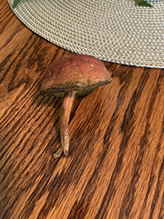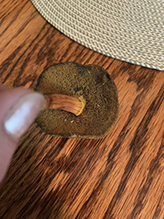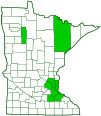Red-cracking Bolete
(Xerocomellus chrysenteron)
Conservation • Description • Habitat • Ecology • Distribution • Taxonomy
Conservation Status |
|
|||||||
| IUCN Red List | not listed |
|||||||
| NatureServe | NNR - Unranked |
|||||||
| Minnesota | not listed |
|||||||
Description |
||
Red-cracking Bolete is an easily recognized, small to medium-sized, edible mushroom. It occurs in Europe, North America, and Japan, and has been introduced into New Zealand. In the United States it is most common east of the Great Plains and west of the Rocky Mountains. It is relatively uncommon in Minnesota, where it reaches the western extent of its eastern range. It is found in summer and fall, alone, scattered, or in small groups, in deciduous and mixed forests. It grows on the ground usually under hardwood trees, sometimes under coniferous trees. It has a mutually beneficial relationship (mycorrhizal) with the tiny rootlets of trees, absorbing sugars and amino acids while helping the tree absorb water. The cap is 1¼″ to 4″ (3 to 10 cm) in diameter. It is convex at first and covered with minute velvety hairs. The upper surface is dry and may be dark olive-brown to dark grayish-olive, grayish-brown, or brown. As it ages it becomes broadly convex to almost flat and conspicuously cracked, especially toward the margins, exposing reddish to pink flesh underneath. This is the feature that gives the mushroom its common name. Old specimens are often reddish toward the margins. The stalk is firm, solid, 1½″ to 5″ (4 to 13 cm) long, longer than the cap is wide, and 3⁄16″ to ⅝″ (0.5 to 1.5 cm) thick. The color is variable, but it is often yellowish toward the top, reddish in the middle, and purplish at the base. It sometimes has broad longitudinal ridges. The pore surface is yellow when young, becoming brownish or olive with age. It stains blue when bruised. The spore print is brown to dark olive-brown. The flesh is fairly thick and whitish to yellow. It slowly turns blue when exposed to air. It is edible but when cooked the texture is unappealing and the taste is bland. |
||
Similar Species |
||
Habitat and Hosts |
||
Deciduous and mixed forests. Hardwood trees. |
||
Ecology |
||
Season |
||
Summer and fall |
||
Distribution |
||||
|
Sources |
|||
| 7/26/2022 | ||||
Occurrence |
||||
Relatively uncommon in Minnesota |
||||
Taxonomy |
|||
| Kingdom | Fungi (fungi) | ||
| Subkingdom | Dikarya | ||
| Phylum | Basidiomycota (club fungi) | ||
| Subphylum | Agaricomycotina (jelly fungi, yeasts, and mushrooms) | ||
| Class | Agaricomycetes (mushrooms, bracket fungi, puffballs, and allies) | ||
| Subclass | Agaricomycetidae | ||
| Order | Boletales (boletes and allies) | ||
| Suborder | Boletineae | ||
Family |
Boletaceae (boletes) | ||
Genus |
Xerocomellus | ||
Synonyms |
|||
Boletus chrysenteron Boletus pascuus Xerocomus chrysenteron |
|||
Common Names |
|||
Cracked-cap Bolete Red-cracking Bolete |
|||
Glossary
Mycorrhizal
A symbiotic, usually beneficial relationship between a fungus and the tiny rootlets of a plant, usually a tree.
Visitor Photos |
|||||
Share your photo of this fungus. |
|||||
| This button not working for you? Simply email us at info@MinnesotaSeasons.com. Attach one or more photos and, if you like, a caption. |
|||||
Amber Rathman |
|||||
 |
 |
||||
MinnesotaSeasons.com Photos |
|||||
|
|||||

Slideshows |
||

Visitor Videos |
|||
Share your video of this fungus. |
|||
| This button not working for you? Simply email us at info@MinnesotaSeasons.com. Attach a video, a YouTube link, or a cloud storage link. |
|||
Other Videos |
|||
| Xerocomellus Chrysenteron - Red Cracking Bolete - How to identify and to prepare them for cooking. The Master Of Random |
|||
About
Sep 11, 2020 |
|||
| Xerocomellus chrysenteron, Boletus chrysenteron, Xerocomus chrysenteron, is a small, edible mushroom Adrian through nature |
|||
About
Jun 5, 2019 Xerocomellus chrysenteron, Boletus chrysenteron, Xerocomus chrysenteron, is a small, edible mushroom I go through the forests, mountains, hills, fields, and waters to understand the living world and to create a living mind. I'm just a man who is on passing on this living earth. A living earth that is closer to death, because of us, of the human being. I spend all my time in nature, enjoying its show. All this time I try to make a video encyclopedia with flora and fauna that I encounter on this living earth. Sometimes with human fauna ... I meet wild mushrooms, medicinal mushrooms, edible mushrooms, dead mushrooms, toxic mushrooms, magic mushrooms. Every wild mushroom with its mystery and story. The living earth is still amazing. I meet plants, flowers, trees, shrubs, grass, leaves fallen on the living land, leaves fallen on the dead land, leaves that dance in our thoughts and soul. I meet insects, invertebrates of all kinds, butterflies, worms, larvae, birds, fish, mammals, reptiles, amphibians... But I also encounter deforested forests, hunters, poachers, animals killed, tormented, in a suffering that words can not express. I also meet people who think it is good that they behave like this. I stretch my hand and save an insect from the drowning. But this people trample under foot my hand. They make their choice. I make my choice. Sometimes I manage to correctly identify the species of living beings: mushrooms, plants, animals, insects. Sometimes not. What I know is much less than what I do not know. I am just a man in front of a knowledge that surpasses me, overcomes us. I do not know enough English yet to make my clips more attractive. But I'm learning...A wonderful life, I wish you all! |
|||
| Xerocomellus chrysenteron - Boletus chrysenteron - Red Cracking Bolete - Bolet à chair jaune 4k The wonderful world of mycology |
|||
About
Nov 25, 2021 On September 30 we made an outing where we found this bolete in a beautiful oak forest. It is easy to identify this species by the reddish color in the bites. It is edible like all Xerocomus, but of low quality. At the end of the video I share a photo of Verónica Díaz of another very similar xerocomus, the X. porosporus that we also saw in the same forest. I hope you like it |
|||

Created: 7/26/2022
Last Updated:


